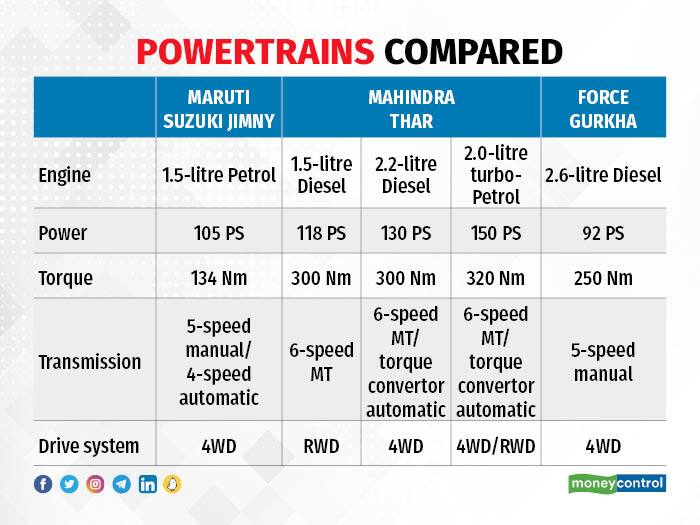



The sport of offroading isn’t big in India, but that doesn’t mean there isn’t a market for it. Enthusiasts constantly seek the thrill of taking their vehicle off the beaten path in search of adventure. And while SUVs obviously fare better than other four-wheelers, only a handful come close to being genuine offroaders. Of these, the Mahindra Thar and the Force Gurkha already have a foothold in the market.
Now, after months of waiting, Maruti has finally brought in another legendary name, the Jimny. But how does it fare against the other two? Let’s find out.
Dimensions
What makes these SUVs, so practical is the way they have been designed and their dimensions. The Jimny, in this comparison, is the smallest, measuring 3,985 mm in length, 1,645 mm in width and 1,720 mm in height. The Mahindra Thar comes next with the same length as the Jimny but 1,820 mm width and 1,844 mm height. The Gurkha, on the other hand, is the largest of the SUVs with its 4,116 mm length, 1,812 mm width and 2,075 mm height.
Surprisingly, however, the Gurkha has the shortest wheelbase, measuring 2,400 mm, while the Jimny has the longest at 2,450 mm. The Thar sits comfortably in the middle here at 2,450 mm. And finally, what makes these true SUVs is how high they stand over the road. The Thar gets the highest ground clearance at 226 mm, while the Jimny measures 210 mm. The Force Gurkha is marginally lower, at 205 mm.

Another aspect people usually look at is the approach, departure and breakover angles. This is vital information to have when treading over rocks and boulders, or you risk damaging the underside of your vehicle. These numbers can also be confusing, so to make things simpler, just know that the bigger the number, the better. The Mahindra Thar has the best approach angle here at 41.8 degrees compared to 36 degrees and the 37 degrees for the Jimny and Gurkha, respectively. It also has the best breakover angle at 27 degrees, but only marginally, against 24 and 25 degrees for the Jimny and Gurkha, respectively. The Jimny, however, has the best departure angle at 50 degrees compared to 36.8 and 36.8 degrees for the Thar and Gurkha, respectively.
And finally, water wading capacity. There is no confirmation for the 5-door version, but the 3-door Jimny can only wade through water that is 300 mm deep, so we are expecting the same number for the 5-door as well. The Thar, on the other hand, can wade through waters 650 mm deep, while the Gurkha can go 50 mm deeper with a water wading depth of 700 mm.
Powertrain
Moving on to what propels the cars. The Maruti Suzuki Jimny is powered by a single 1.5-litre naturally aspirated petrol option. This engine produces 105 PS of maximum power and 134 Nm of peak torque. It gets a full four-wheel-drive system and both a 5-speed manual and 4-speed automatic transmission options.
The Mahindra Thar, on the other hand, has a more comprehensive list of the powertrain options. Starting with the 2.2-litre diesel engine, you get 130 PS of power and 300 Nm of peak torque, full 4WD system and both manual and automatic transmission options. There is also a smaller 1.5-litre diesel engine that comes with a rear-wheel-drive system. This engine produces 118 PS of maximum power and 300 Nm of peak torque. It is also mated to a single 6-speed manual transmission. The Thar’s most powerful motor is a 2-litre turbo-petrol engine that produces 150 PS of maximum power and 320 Nm of peak torque. This engine comes with both 4WD and RWD drive system options as well as a 6-speed manual and automatic transmission option.

Finally, the Gurkha gets the largest engine of the lot. However, this 2.6-litre diesel engine is also the most underpowered engine in comparison. Producing only 92 PS of maximum power and 250 Nm of peak torque, the transmission is limited to a 5-speed manual gearbox. 4WD does come standard, though, so it’s not all that bad.
Features
Next is something that will matter when you’re not crawling through mud and rocks and just cruising on your daily travels: creature comforts. The first thing to note is that you won’t find everything you might usually want. But everything you will use is in there. All three SUVs for example, get touchscreen infotainment systems complete with Android Auto and Apple CarPlay. The Jimny has the biggest system here with a 9-inch screen and an Arkamys sound system. The Thar and the Jimny, however, are slightly more feature packed than the Gurkha, with cruise control, electrically adjustable OVRMs and electronic stability control.
The Thar and the Gurkha get two airbags for safety while the Jimny comes fitted with six as standard. The Thar and the Gurkha also get a tyre-pressure monitoring system which will be extremely useful in the wild.
Price
Finally, how big a hole will these SUVs create in your bank account? Unfortunately, Maruti Suzuki hasn’t announced prices for the Jimny just yet. The Mahindra Thar, on the other hand, starts at Rs 9.99 lakh going all the way up to Rs 16.29 lakh for the top-spec trim. The Force Gurkha is available in only a single trim, priced at Rs 14.75 lakh.
Discover the latest Business News, Sensex, and Nifty updates. Obtain Personal Finance insights, tax queries, and expert opinions on Moneycontrol or download the Moneycontrol App to stay updated!
Find the best of Al News in one place, specially curated for you every weekend.
Stay on top of the latest tech trends and biggest startup news.